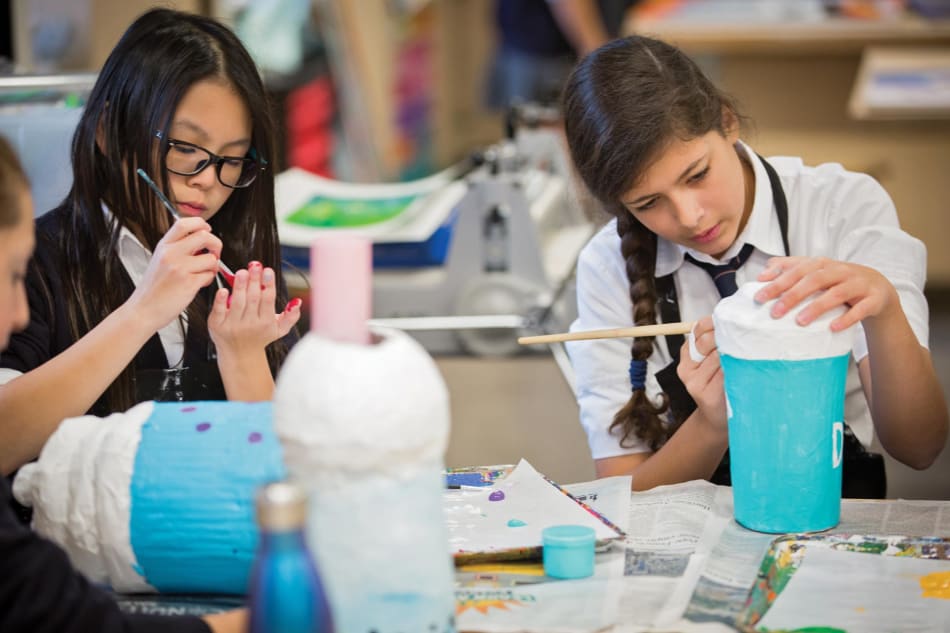The York School THE OUR KIDS REVIEW
The 50-page review of The York School, published as a book (in print and online), is part of our series of in-depth accounts of Canada's leading private schools. Insights were garnered by Our Kids editor visiting the school and interviewing students, parents, faculty and administrators.
Our Kids editor speaks about The York School
Introduction
The York School was founded in 1965 as a preschool, though it has grown considerably since then, all the while reflecting the changing cultural and academic ideals of the age. The ’60s saw a rise in hands-on, inquiry-based instruction, as well as a greater attention to values, including the value of academic achievement. The approach to preschool instruction was a starting point, and it continued with the creation of the Junior School in 1978 and the Senior School in 1998.
York grew to become the definition of an urban school, due largely to how it interacts with the resources the city provides. It’s one thing to be located within a city, and yet another to have a significant, daily interface with the surrounding city, something that York demonstrates better than most, both literally and figuratively. The entry to 1320 Yonge, home to both the Middle and Senior schools, is akin to a subway entrance—students walk down a ramp and turn to enter the main doors rather than, say, walking up a flight of stairs and through an ivy-draped arch. There is a Freshii outlet in the cafeteria, and pedestrians sometimes try to come in, thinking it’s a public food court. They can’t actually get in—the entry is staffed and secured—but the administration delights in those kinds of misconceptions. It means they’ve succeeded in creating a space that blurs the lines between the life and culture of the school, and the life and cultures of the city beyond. There are windows everywhere, looking out at the street scene, the people, as well as some views of the skyline beyond. From some spaces, you can see as far as the Toronto Islands.
Those design elements—created during the recent renovation—play a part in ordering the perceptions of the school as well as the students’ perception of their relationship to it and to each other. Classrooms and a cafeteria are visible from the street, with the pedestrians looking in as much as the students are looking out. Also with the new design, the school included a gender-neutral washroom. It’s useful and efficient, though significant too of the overall approach: forward looking, ahead of the curve, inclusive.
The students appreciate that blurred line between city and school. They see themselves as true urbanites, and they comport themselves in that way, with confidence and independence. The closest subway station is 200 metres from the school; the next closest isn’t much further. It’s an easy walk from either Summerhill or St. Clair station, past coffee shops, a Book City outlet, cafés, grocery stores, offices—all the bustle that Torontonians rightly delight in.
All of the middle and senior students we spoke with take the subway to school each day. Where the approach to so many other schools is through a tangle of cars and buses doing morning drop offs, the approach to the York School is more efficient, and students arrive of their own volition, managing their own time. “We always say that the city is our playground,” says Praveen Muruganandan, Director of Admission and Advancement. He recalls a time when the buses were late arriving to the school to take the JKs on a field trip to the Royal Ontario Museum thanks to the morning rush hour. “So the teachers said, ‘you know what, we’re going to take the subway.’” The accessibility is nice, though the lessons learned are too; from a young age, the students are finding their way in the world beyond the school.
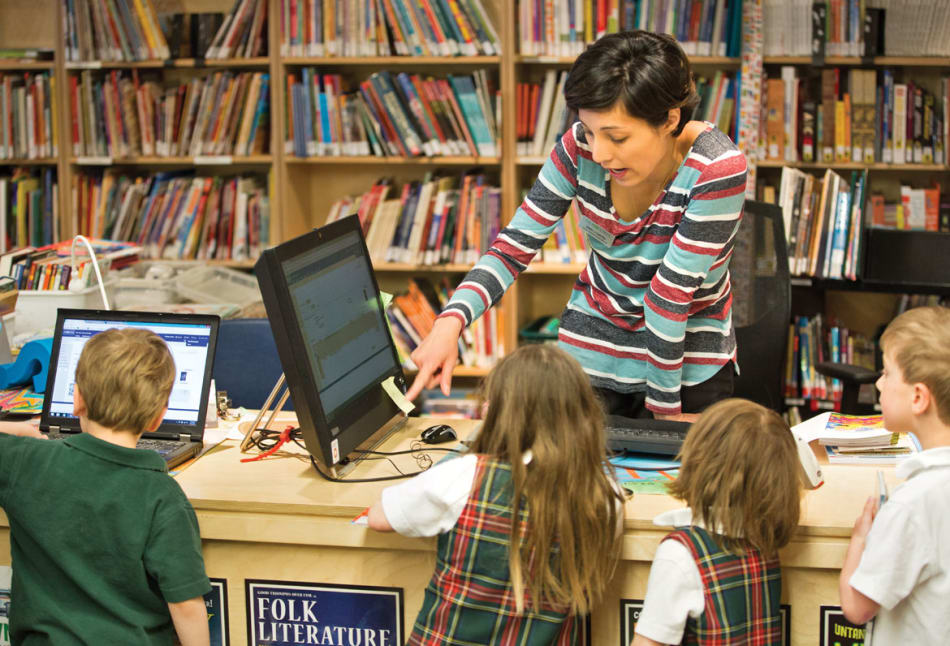
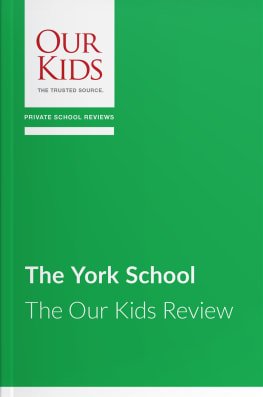
Key words for The York School: Urban. Innovative. International.
Basics/Background
The York School is a non-denominational, coeducational day school in the Summerhill area of downtown Toronto. It offers a liberal arts education and includes a Junior School at 1639 Yonge Street (comprising JK through Grade 5), and the Middle and Senior Schools at 1320 Yonge Street (comprising Grades 6 through 12).
It was founded by Barbara Goodwin-Zeibots. At the time, she had young children and was looking for an early education program that was more progressive, more reflective of her values, and offering a higher standard of academic engagement. Unable to find one, she got together with a few other families who were looking for the same thing and, under her direction, they created one. Barbara Galbraith was one of the first parents of the school. She recalls “I was looking for a kind of environment where a child would be encouraged to explore, use a lot of materials, learn through experience.” Galbraith later became a teacher and administrator at the school. “We were all really involved in making decisions that affected the school,” recalls Diane Dowman, a retired teacher and past head of information technology. “You really felt that you were making a difference, all the way along. … You really felt that it was much more than a job.”
Founded as a primary Montessori program and located within a church basement, as the students grew, the school did, too, often by a grade at a time. In 1978, the elementary program was formalized; the first Grade 8 class graduated in 1985; and the Senior School was founded with the addition of Grade 9 in 1995. “It was a very creative environment,” says Galbraith. She recalls that the entire faculty could fit around a single table in the lunchroom. “We would have great discussions. [We’d] talk about curriculum, and it was very exciting to put those ideas into practice.”
The motto at the time of the 30th anniversary in 1995 was “experience teaches,” something that came out of the Montessori experience, though also foreshadowed the adoption of the International Baccalaureate (IB). “There was a great desire among teachers,” says David Hamilton, past principal, “to have students experience not merely through book learning, but also out of classroom experiences. … it meant getting out of the school, and being involved in all aspects of life … Some very special teachers came along with ideas, and we just went with those ideas and built upon them.”
Goodwin-Zeibots remained at the head of the school through the majority of its life until what she intended to be her retirement in 2006. As with many retirements, it didn’t quite take, and in 2009 she founded the Global Pathways School in Chettipalayam, India, to provide a quality education to students living in poverty. While she is no longer is active in the daily life of the York School, her spirit remains (as does her portrait, which looks out from behind the lending desk in the main common area of the Senior School).
The second head of school, Ezio Crescenzi, came from a long career in the Dufferin-Peel school board, and led the York School until 2011. Conor Jones became head of school in 2011. Initially hired by Zeibots as a teacher in 2002, later serving as director of advancement, his time at York marked a key period of growth, one apparent in the transformation of the learning and common spaces. He worked with Robert Davies of Montgomery Sisam Architects, and they took Toronto’s Centre for Social Innovation as a primary model. The York School presents extremely well from an aesthetic perspective—bright, fluid, and open—though the design was intended also to bring collaborative engagement and cross-curricular instruction to the fore. One space (it occupies the space that was previously home to the administrative suite) can be converted using roll up doors—you’d call them garage doors if they didn’t look as good as they do—between a single space, or variations of two or three independent spaces.
Leadership
Struan Robertson is the current head of school, and while he’s new to the role, he’s not new to the school. Most recently, he served as the Junior School principal and deputy head of academics. Prior to arriving at the York School, Robertson was principal at International School Bangkok (ISB), in Bangkok, Thailand, returning to Canada to become head of school at Lakefield College where he redeveloped the school’s approach to wellness, creating the Character Values program, and THRIVE, a preventative mental health initiative.
Robertson is athletic and lives an active life. Among other things, he coaches hockey in his children’s league. He jokes that he rarely sits down, and given that he has a stand-up desk, it’s actually not a joke at all. He really rarely sits down. “We learn and think and do when our bodies and minds are active,” he says. “Growing up with my siblings, we were always so active. Pushing boundaries, testing things. It was like mom and dad were running a summer camp STEM lab. And through that I became a camp counsellor and, over time, learned that my passion was to teach and encourage those around me.”
“Going into education was an extension of summer camp for me,” he says, in that it allowed him to continue working to affect young people’s lives in positive ways, imparting the values of activity, resiliency, diversity, and empathy. Of the things he appreciates about his role is the ability to “make people feel really good about what they do, and build that culture of feeling appreciated, challenged.”
“We’ve got a high level of academics, a high level of arts, a good level of athletics, our debating is off the charts,” says Robertson, “but we’ve got a wide range of programs [so all types of learners] are able to find their place, and that’s something we continue to embrace.”
Academics
The York School was created to appeal to learners who were inclined to academic achievement, and who share a specific approach to learning. It would be wrong to say that all the students at the school today are of a piece—certainly that’s not true anywhere—but the ones that we met shared some attributes, including a positive outlook and a willingness to dig in to some of the unique aspects of the offering. The ICE program is one that they reference often, including the ability to get outside the school and to explore their interests as they discover the world around them. That kind of culture comes directly from the leadership team and the ways in which they communicate the core values. “They ask the students to be citizens of the world,” says parent Scott Rattee, “to identify problems and then create solutions. This is exactly what the school does—they teach by example. It is terrific to see.”
All York students graduate with both the International Baccalaureate (IB) diploma and the Ontario Secondary School Diploma (OSSD). While there are similar schools in which the IB is optional, there is a belief here in the benefits of not allowing students to opt out. “We help them strive to meet that potential,” says Muruganandan. “We have a relatively small graduating class—about 60 students—and if 20 kids choose to do only the Ontario diploma, it’s just not fair to the other 40 kids who are working their tail off to meet all the requirements” in order to complete the IB.
The York School was an early adopter of the full IB curriculum, the first to do so in Canada and the just the fourth in North America. When it was developed in Geneva in the 1960s, the IB was meant initially as a program for children of diplomats. It became a program of choice in part because it was transferrable. Where other curricula are developed nationally, the IB is consistent, rigorous, highly regarded by university admissions officers, and offered at schools around the world—public, private, and independent. As such, students can move between IB schools, picking up the curricular threads exactly where they left off. A student we spoke with who arrived from Copenhagen said that one of the attractions for her was the fact that her friends, while distant geographically, were having a shared academic experience. “Being in Toronto, I can relate to someone in Barcelona or Copenhagen. … It’s really interesting, and it’s easy to stay connected.” She talked about how she’s in touch with friends in IB schools overseas, mentioning that she’s struggling a bit with chemistry, “and they’re like, ‘yeah, me too, we’re doing redox equations.’”
In the 1960s and 1970s, the IB was developed with that kind of transferability in mind. Today, however, the greater draw is what the curriculum offers. It’s challenging and delivered through an international lens. The curriculum is project-based and interdisciplinary, with culminating projects at key points in a student’s development. “The best kind of learning is when kids are totally embedded,” says Robertson, referencing the project-based, cross-curricular approach adopted at the school. “It’s not like you’re in reading now, and then writing, and then math. The whole approach is to integrate it together into units of study.” Instruction is collaborative, both between students and between instructors. “The opportunity to embed the learning into everything they do is, I think, something that we do well.”
The latest capital campaign resulted in a significant redesign of the campus, and many of the spaces within the Middle and Senior School at 1320 Yonge are unrecognizable from what they were prior. The space that was the administrative offices is now a cutting-edge studio space, with garage doors—descending partitions with glass panels—that allow for the space to be divided into three, or one big and one small, or an entirely open space. Just as the lines between city and school are blurred, spaces like that one blur the lines between engineering, design, and art—which, of course, is exactly the point.
Helen Gin, principal of the Middle School, came to York after working in the public system and teaching in IB schools in Europe and Japan. As with other members of the faculty, she was drawn to the strengths of the IB first through those experiences teaching in IB environments overseas. “I like the IB mission,” she says, including the overarching understanding that “I’m on this earth to evoke some positive changes, to better the lives of others.” Says Gin, “The IB wants to produce students that are going to be creative problem solvers … engaged citizens, so that they contribute to a more peaceful harmonious world.”
While the Middle School is rightly set somewhat apart, with classes and common areas on the fourth floor, Gin says that “it’s not really a particular place,” but rather, “a set of experiences. … I think these grades are really crucial grades because it is a time of tremendous growth.” She notes that it’s a period of emotional and social growth, second only to infancy. “There are new concepts, new opportunities, new kinds of thinking.” As such, she feels it requires a unique approach and that promoting community service in high school is very different than in middle school. It’s a time to build the foundations, and the inquiry-based responsibilities, that will serve them when they advance to the high school IB environment. Likewise, the curriculum allows instruction to follow concepts across disciplines, with the same question being posed in a science, English, or math class, giving students a chance to view the problems through a range of different lenses. The faculty work to ensure that this is the case, allowing students to engage with concepts in a variety of ways.
The Middle School approach is pragmatic, grounded, and encouraging. The instructors are keen to find entry points into the material that will keep the learning alive and students engaged. One student tells us: “I don’t like talking in front of people. It’s one of my worst fears. Last year, we had to do oral assessments—we had to choose a topic and present it to the class. And when I first heard about it, I thought, ‘no way, I’m not doing that at all.’ But then I met with [my teacher] five times, so that I could practice and get used to being in front of people. And it was a big decision for me; after meeting with him, it helped build my self-confidence and I ended up doing it.” When asked if it was fun in the end, she answers with a blunt “no.” But the fact that she told the story to us says something about how important that experience was to her.
Experiential learning
During Hamilton’s tenure, the school developed the Integrated Canadian Experience (ICE) program, a combined study of Canadian history, geography, civics, and literature undertaken by all Grade 9 students. On the surface, the intention was to provide an immersive experience, getting the students beyond the textbooks and the classrooms, interacting with the curricular concepts first hand. The broader goal was to further develop the school’s goal to make students truly citizens of the world.
“These kids are spending half of their time basically outside the building,” says Muruganandan. “They are literally running around the city. They’re making documentaries, they’re learning about the communities—Little India, Chinatown, Little Italy [and so on]—and they’re learning from the people. The city is our classroom.” It’s not always easy or comfortable. Interviewing can itself be a stretch for some students, approaching people from other cultural backgrounds can take students further outside of their comfort zones. And that is the intention.
At the same time that the ICE program was created, the school also developed Challenge Week, which extends the concept. During Challenge Week, students from Grades 6 through 10 go even further afield on trips lasting from two nights to a week. From Grades 6 through 7, the destinations are more typical, more programmed, including Montreal, Ottawa, Vancouver, St. John’s, and Quebec City. In Grades 9 and 10, students are given options, and can choose from adventure trips, such as hiking in the Rockies, to cultural trips, such as to New Orleans. They’re fun, of course, though they’re also keyed closely to the curriculum. Says Robertson, “all reflect the attributes of the IB learner profile,” both in terms of content and experience, namely “doing something outside your box.” On a recent trip, for example, music students were challenged to busk in New Orleans’ French Quarter. Another group explored the concept of the Resilient City, touring and evaluating the city’s ongoing response to hurricane Katrina, socially and environmentally. “They were investigating how you build resilient cities, and [how you] repair tears in the social and environmental fabric of a city.” The challenges across all of the experiential programs are intended to be multi-layered: social, personal, and academic.
The Junior School
The Junior School is just north of St. Clair on Yonge Street, a five- to 10-minute walk north of the Middle/Senior School. It’s positioned as a satellite campus. Administration is very much appraised and aware of the whole school initiatives, and are part of senior leadership. The vision is shared, as is the sense of continuity between the two locations. There is one school newsletter and many citizenship events, such as the Terry Fox run, that flow across both campuses.
The Junior School reflects the feel of the main campus—there are lots of clean lines and a very modern design—though perhaps in a cozier way. There are open spaces, with lots of wood and warm lighting. While it is a part of The York School, it does have a lovely character of its own. The play spaces to the back can be seen from various points in the building, including principal Valerie Turner’s office. Turner became principal of the junior school in 2019, bringing with her 18 years’ experience as principal at Havergal College, the Latin School of Chicago, and Robbins Hebrew Academy. She looks out on the playground, and the children there are free to look in, and to see her working, meeting with teachers and parents. Says Turner, “What I love most about the space is that I can open the window and I can hear the children playing.” That underscores a porousness of the environment, one that the students find comforting—this is their space, and they have access to all of it.
In true IB fashion, the programme is rigorous. The PYP culminates in an exhibition, which is a year-long project which the students present in May. They each need to seek out a mentor, develop concepts, do research, and ultimately present their work to their peers and teachers. Parents appreciate the challenges the curriculum provides, though, by the same token, there’s a playfulness to the programme such that the students don’t feel that the challenge is onerous. There’s a balance, whether it’s after-school activities or athletics, that encourages the students to balance their lives. Rigour is offset by activity, values, and involvement. Innovation, too, is valued, though within certain parameters. Says Turner, “I think to be innovative is to be able to move nimbly as progress in education changes” in terms of development of global perspective as well as cultural competencies. “It’s more about being able to act than it is coming up with visionary ideas that haven’t been explored.” Where some schools posit innovation as adopting new teaching practice, for Turner the concept of innovation is more centred on the needs of the students, and how they will be challenged as they move ahead in their education and beyond. “Because The York School is not a storied place, like schools that have been around for one and two hundred years, managing change is something people are inspired by, not something that people are worried about.” There are also fewer layers of bureaucracy, and flexibility is prized, as is professional development.
Technology is a priority, though there is also a very considered, thoughtful approach to its use. It’s embedded in learning motivation, used rightly as a tool rather than a means to its own end. “We really only use technology in ways that it authenticates the learning context in a real world sense.” If students are working through a problem and technology can help them solve it, then technology will be put into place at that point. The overarching feeling is that technology shouldn’t be allowed to run the show, but rather be positioned as a tool to be used judiciously. There are no Smartboards in the Junior School—they are de rigueur in other settings—because they were found, after some experience with them, not to be the right tool, being one that will enhance the learning, rather than become a focal point.
Size is an important factor of the program, something Turner refers to as the small school advantage. “It’s the relationships that you have with kids. Our teachers know their kids extremely well, but they’ve also known the kids as they’ve been growing up.” There are only two classes at each grade level, so the community is very tight knit—the kids know everyone in their grade level, to be sure, as well as perhaps a majority of those in the grades adjacent. That said, the Junior School has the benefits of both a small and a large school—while the junior facility is contained, it shares resources and expertise with the Middle and Senior Schools.
The goal of the junior program under Turner’s leadership is to develop a sense of care and opportunity, and to have a growing sense of cultural and environmental stewardship: To know that “their contribution means something.” As with the other administrators throughout the school, Turner is a vocal, approachable example of all those core values. She joins the kids for lunch every day, a time that she cites as one of the most satisfying of her work within the school. “It gives me an opportunity to get to know the kids, and to help triage whatever problems they’re experiencing that day.” The kids know she’s the principal, and that she’s always there. “I’m able to learn about their sensitivities, and to help them develop a toolbox of strategies to solve problems. For me, that’s a highlight, because that’s when I’m closest to the kids in the most positive way.” Parents, particularly, appreciate that level of interaction and care.
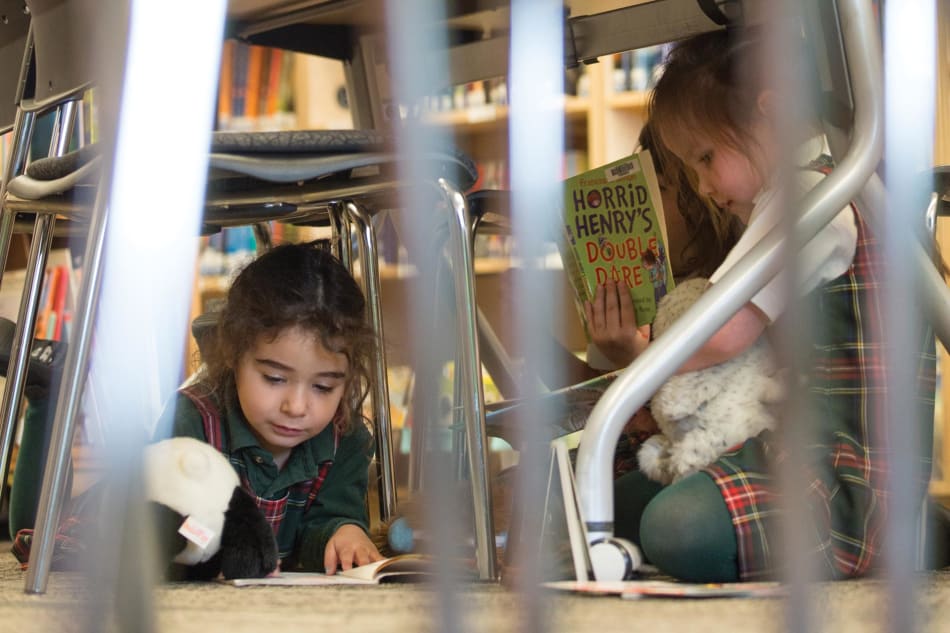
Academic environment
“The school makes it very hard not to succeed,” says a Grade 11 student. He references the range of resources available, and certainly there’s a very robust program of learning supports, both formal and informal. “The teachers will go out of their way if they see us struggling, to make sure that we don’t continue to struggle. … You’re never forgotten. All the teachers know you; the counsellors are open and willing to help.”
Faculty work to form students’ understanding of what success means, and that it isn’t limited to marks, which is very nice to see. Balance in life is a value of the school, and one that is apparent throughout the facilities. Says another student, “I just think the school wants to see us get to the place where we want to be, even if we don’t necessarily know what that is yet. … they want us to be prepared … to build a foundation here to be able to do whatever we want, and meet what we think success is—what our personal idea of success is.” One student described having his wellness advisor make a schedule that helped dismantle what was becoming an overwhelming workload into bite-sized and manageable pieces. He credits that intervention with effectively addressing his rising anxiety and subsequent success.
There was a time when all schools were focused only on academic excellence, and they charted as straight a course to it as possible. Failure wasn’t an option. Times have changed, as have our perceptions of excellence, failure, and success. Andrew Bosworth, a former teaching assistant at Harvard and now a chief advisor to Mark Zuckerberg, has said that “failure can be a form of success. It’s not the form you want, but it can be a useful thing to how you learn.” That idea is shared throughout the faculty. “If we can teach them to fail here,” says Struan Robertson, “that’s the resilience and the structure that will allow them to bounce back and to fail forward.”
Marks matter, says David Hanna, director of university counselling, but each student’s story—how they develop over their time at the school—matters, too. “We provide those vehicles where students can grow into something pointy. The whole notion of a well-rounded student is not the ultimate … well rounded in everything, awesome in nothing. We want our students to have a story where they’re a little different in something, and that’s going to separate them from the pack. … and if we can align that pointiness with their post-secondary aspirations, fantastic. Consequently, that is giving our kids the edge, in addition to the marks, to getting [into] some of these more selective programs.”
Just as in the upper schools, the Junior program is based on the values of being an urban school, and instructors seek to make the most of the vast resources the city provides. There are a lot of field trips that happen through the course of the year, be they to attractions or simply out into the neighbourhood, and they allow students to take advantage of nearby green space. The Canadian National Institute for the Blind (CNIB) is nearby, and there are those kinds of partnerships as well, providing opportunities to build concepts of diversity and citizenship. “You know, we’re tapping into the community,” says Robertson, and bringing it all back to the connections they make within the IB curriculum.
Programs, curricula, support, infrastructure—those things are all important. But it’s refreshing that, when pressed, it’s the comfort and safety of the environment that is at the top of the list of what the school is working to deliver. And it shows. When you walk in, it does actually feel very good. In the Junior School, there are kids helping in the library and playing in the play spaces. There are coats and shoes all lined up along the wall. The spaces are bright, colourful, and engaging. All of that provides the basis for a strong, thoughtful, forward-looking primary and elementary program of study.
While the main campus building wasn’t created to house the school, you wouldn’t know it, thanks to the last capital campaign. Again, the school was designed to have a clean, atypical feel. We asked the chemistry teacher what she liked best about her lab, and she listed exactly those things: light, movement, a space designed for co-operative learning. “This fume hood is great,” she added as well, perhaps in the way that only a chemistry teacher might. On the less prosaic side, she also has a “wall of memes,” one of which reads, “Do you know any jokes about sodium? Na.” She says, “That’s part of the reason I like chemistry so much; it makes for great puns.”
One of the reasons the students love learning with her is because she knows how to relate to them, to have fun, and to communicate a love of chemistry along with the course content. While students may not think about this much, if at all, the spaces have been created with their needs and desires foremost in mind. “It’s a multi-purpose space, not just a chem classroom. If I want to have a discussion in here,” she says, noting the horseshoe arrangement of the lab tables, “it’s easy to do.” In that, and so many other ways, the facilities throughout are both inviting and efficient, designed with the core values and curriculum delivery in mind.
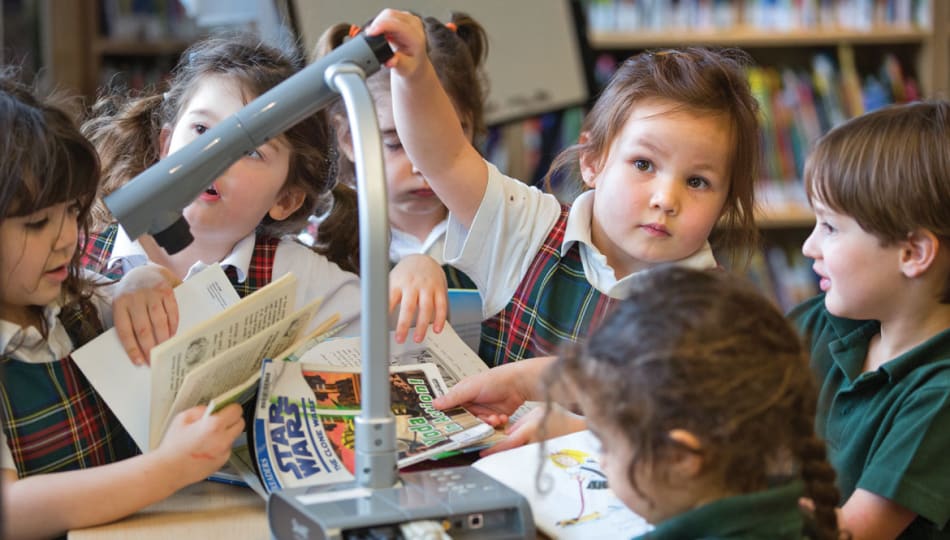
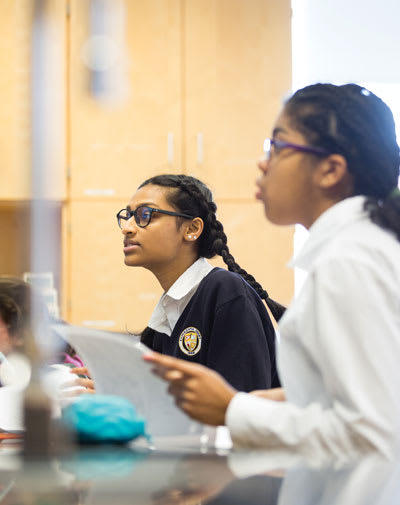
Student population
The school population includes students from 35 different countries. That’s unique for a day school, and something York rightly sees as a strength. Talking about world issues in a classroom with so much international experience and perspective can bring conversations to life.
A student commented that York is “a small school, but it’s big enough. It’s big enough that when people annoy you, you have some place to go. But it’s not so big that you don’t have to come back and deal with it later.” There are 750 students in total. The national median for secondary schools is 350, so even though the York population is divided between two campuses, it still isn’t tiny. That said, what the students respond to aren’t the demographics or the enrolment numbers, but rather the lived experience of the school. They feel it’s small because it feels close knit. As one student noted, “we all know each other’s names.” We asked a classroom of students what they like about the school, and the first response was “I like these people.” That kind of thing doesn’t just happen, but rather is a function of how the school has managed its population over the years. Peer mentoring, as well as teachers that teach across grades, helps to reduce the sense of the size of the school. “There is a great student-teacher relationship and a continuum that doesn’t end when a student moves into the next grade,” says parent Scott Rattee. “Teachers are invested in the children until the day they graduate.” The students feel they all know each other, and because of their interactions throughout the school and the development of those ongoing teacher-student relationships, they do.
While academic achievement isn’t the sole source of social capital—or even a primary one—there is nevertheless a clear culture of achievement. Students share a belief in the value of academics. It’s much like playing tennis with someone who’s a bit better than yourself—it brings your game up. There isn’t a sense of competition, but academic engagement is seen as a worthy goal.
A diversity of interest characterizes the student population as well. This isn’t a school where the one goal is to go to MIT, but rather students find areas of interest beyond what they might initially conceive. That’s something the school actively seeks to achieve, through a robust program of university counselling. And they do. The 55 students who graduated in 2017 (the last graduating class for which the data has been compiled to date) entered 44 different post-secondary programs, including an increase in students entering STEM-related fields.
Athletics
“Sport is a great educator,” says Rick DeMarinis, director of athletics, “and learning takes place on the field, on the court,” ranging from interpersonal skills to learning the value of activity. He feels that competition is important for advancing in a sport. That’s certainly relevant for some students, particularly at the high school level, though DeMarinis is clear that competition isn’t for everyone, nor should it be. “For younger athletes, it’s about fostering an appreciation for sport and activity.”
DeMarinis (the students call him “Mr. D”) has been at York for 15 years, and under his direction, those are the core values that inform the athletics program. “I think it’s about balance, and balance for me doesn’t mean that you have to be involved in everything. For me, it means that you have outlets in life that bring you happiness and pleasure, whatever that is. And I think that’s what we promote here.” All that said, he’s a champion of the idea that everyone needs a physical outlet—going for a walk, yoga, strength training, team sports—and he actively promotes offerings that range from recreational to competitive.
The creation of the athletics spaces is a study in space efficiency, to be sure, a good portion of which are a product of the recent infrastructure development. Facilities include a double gymnasium (Middle and Senior Schools), a junior gymnasium (Junior School), a small turf soccer pitch (Middle and Senior Schools), an indoor 100-metre track, and a fitness centre. In that, and much else, the athletics program is bigger and more robust than you might expect, given the school’s size and location.
The teams compete within the Conference of Independent Schools Athletic Association (CISAA), earning 21 championships and counting since 2014, and in Canadian Accredited Independent Schools (CAIS) national tournaments. The primary sports are boys’/girls’ basketball, soccer, and volleyball. In total, there are 56 competitive teams and more than 100 programs. There are all the usual suspects, as well as some that are less usual, such as golf, squash, and ultimate frisbee. When facilities aren’t available on site, the school partners with local athletic clubs and schools. They also make great use of the green space nearby. That includes access to ravines and green space, like the Beltline Trail that is just north of the campus. Those spaces are used to good advantage in science instruction, art, and outdoor education. The day we visited, the school was getting ready to mount the annual Terry Fox Run, which runs up Yonge Street, through David A. Balfour Park, Mount Pleasant Cemetery, and the Beltline Trail—all spaces that, apart from being great places to run, are rich with the natural, cultural, and social assets of Toronto.
The fitness centre is as good as we’ve ever seen, and includes virtual personal training. Students are instructed in how to use the gym, and they have an account with the virtual trainer. They put in their student number, and a virtual person—the one we saw had an Australian accent—leads them through a workout designed for them, taking into consideration their size, age, and activity levels. It’s perhaps not quite as good as an actual trainer, but it’s not far off. It also adds flexibility to the program, and students can come by whenever they wish. It’s a very nice addition to the suite of programs on offer, and it’s open during the day as well as before and after school.
At the other end of the spectrum, DeMarinis created the Athlete Institute, a weekend program that brings in professional coaches and athletes to workshop with students from Grade 3 through the high school years. It’s sports specific, giving the more dedicated athletes an opportunity to build their skills and hone performance along with like-minded peers and mentors.
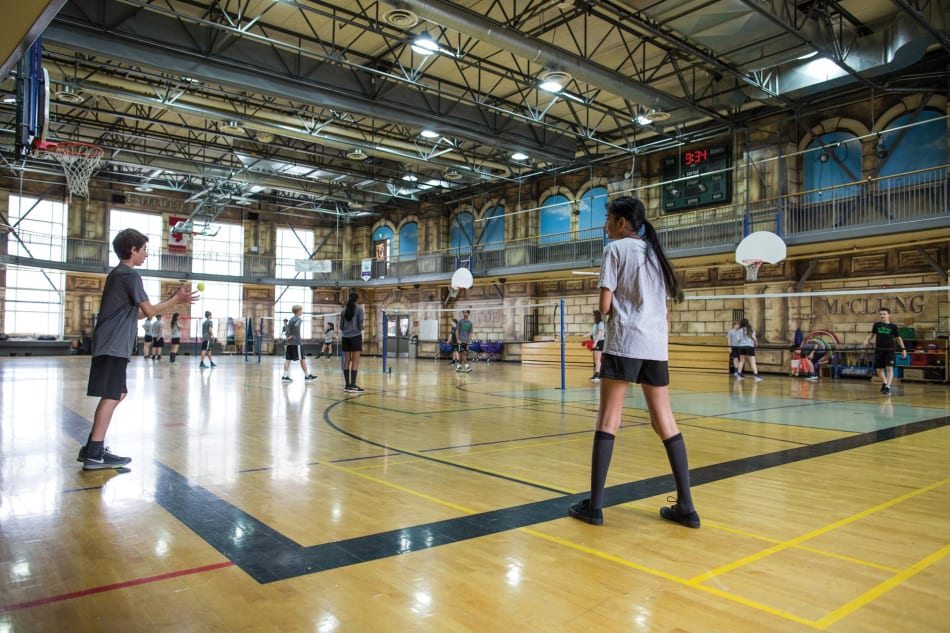
Wellness
The wellness program includes a variety of elements, based on the understanding that kids are only open to learning when they feel safe, comfortable, and accepted. The other core piece is an understanding that relationships are critical to a feeling of safety and acceptance. “If I had to pull out anything that feels unique to the school,” says Elissa Kline-Beber, director of student wellness, “I’d say that the relationships that kids have with the adults in the building are powerful,” something that staff and faculty work hard to foster. Kline-Beber adds: “one of the strengths of being a small school is that I can say with confidence that, if a student is really struggling, someone here is going to know about it.” She admits that’s a bold statement, but notes that it’s borne out by experience. “When teachers have noticed that a child is struggling, I’ll get, in a day, four or five phone calls, saying, ‘do you know what’s happening here?’” For her, it’s a sign that the program of wellness, as a whole, is working as it should. There are counsellors within the school who are known and approachable, and the staff and faculty clearly see wellness as part of their roles as well.
Each student in Grade 9 is assigned an advisor who will follow him or her through their Senior School years. They meet weekly with the same group of roughly 10 students, and can also meet them one on one. Advisors are also kept aware of each student’s ongoing success within the school through Trail Mail—a tracking/reporting system created by the school—as well as a series of email notices that go out with the results of summative assessments such as projects, major presentations, and exams (the latter are also sent to parents). York’s system allows a unique perspective on the students, and it provides a point person should parents have any concerns along the way. By and large, advisors are the families’ initial points of contact.
Trail Mail and other initiatives are aspects of the provision of social-emotional learning (SEL), something that the school clearly takes very seriously. It’s informed by the notion that social and emotional learning is as important as mastery of content and concepts. Says Klein-Beber “[it]isn’t just intuited, but that it’s a skill set that we need to teach in the way that we teach other skill sets.” Frustration tolerance, social skills, self-regulation, executive functioning—all of those kinds of skills are formalized within the SEL curriculum that has been developed by the wellness team and is delivered by the advisor program. The Junior and Middle School students don’t have advisors, though they have homeroom teachers that fulfill the same role. In all, there is a teacher that has that overview role for each student, one who knows the student well and who is also seen as a primary contact for both the student and parents. In the Junior School, there is also a counsellor specifically tasked with delivering the SEL curriculum in a manner appropriate to the needs of the population.
“I think we’re really trying to tackle a range of issues in terms of digital citizenship and digital wellness, which obviously impact so much of our kids’ overall wellness,” says Kline-Beber. The wellness team is creative in how they do that, and they are open to test any strategies they feel could be beneficial. One homeroom teacher has been beginning each day with a guided meditation. The intention is to expose students to that strategy, and many others over their time at the school, so that they leave with both an understanding of the place wellness should take within daily routines as well as a tool box of interventions to achieve it. As Kline-Beber explains: “We’re trying different things, just seeing what’s going to resonate with them. You know, they can be tricky customers.” The approach feels fresh, up to the minute, and robust. Kline-Beber herself perhaps embodies that. She’s personable, affecting, and open, all qualities that she hopes to impart to the faculty. She is also clearly keen to listen to the students themselves. She talks of meeting with the students involved in running the digital citizenship program and hearing from them that the curriculum was out of date in terms of social media use. (“They said, ‘this is old people’s use of social media.’”) She took that to heart, and with them redeveloped the approach to social media awareness.
There is a mentor program, where the Grade 11 and 12 students mentor those in the younger grades. “We do best when students speak to other students,” says Kline-Beber. Mentors and mentees meet weekly, attending each other’s sports events, meeting for lunch, or just dropping by to say ‘hi.’ The mentor group is run by two student directors of school climate and culture. Those kinds of student-led programs are seen as an important part of the spectrum of care, giving students the strategies they’ll need to face what they will face, and contributing an important piece to each student’s sense of their place in academics and in the world. “I want kids to walk out of here thinking, ‘I know who I am as a person, I know who I am as a learner, and I know who to ask for help,’ and really believing that seeking help is a sign of strength, not of weakness,” says Kline-Beber.
The wellness centre is open, visible, centrally located, and actively promoted as integral to life within the school. There is a counselling staff of four, plus a director. Two are licensed social workers. York is clearly focused on students’ mental well-being, as Kline-Beber explains: “What I believe at my core is that there is a real crisis in mental health, and what I see is that we have an opportunity—in a small school, where students are known to us—to develop skills.” She adds that, if the students are going to have any struggles, “I want them to fall apart here” at York, “where they have teachers and parents who are close by and who really care about them.”
Discipline
The guiding principle at the school is that kids benefit from boundaries, and they do best when they are clear on what’s expected of them and held to those expectations. If a student is chronically late, for example, the approach would begin with a conversation with their advisor to probe the structural things that are contributing to the chronic lateness, and then look at strategies to amend it. “We’re pretty sure that detention isn’t going to help,” says Kline-Beber. The desire is to work from restorative justice best practices based on empathy and understanding, while also fostering a sense of responsibility. Mistakes are seen as a part of life and a part of learning, while boundaries are clear and enforced. In more serious cases, a suspension wouldn’t be unheard of in order to protect student safety (although it would be rare).
University counselling
“We shouldn’t be asking kids what they want to do when they grow up,” says David Hanna. “We should be asking them what problems they want to solve when they grow up.” Hanna is the director of university counselling, an office that he founded in 2000, and he’s prone to saying fantastic things just like that. A visit to the school is recommended for any family considering enrolling, and if you can fit in a quick visit with Hanna, so much the better. His perspective on achievement and university placement is refreshing and effective. He’s formed the program of academic counselling around the belief that the goal isn’t to be something, but to do something, and to deploy your talents in meaningful, productive, and satisfying ways.
He says that “All [private and independent schools] have very good university counselling offices, but I think we’re unique in the sense that we are deliberately and strategically able to synthesize how that university placement isn’t just something that happens in Grade 12. It’s a process that we’ve articulated and we initiate from the first day of high school.” He means both that it’s an ongoing process, as well as a multifaceted one.
One such facet is a phone app that he created. It’s called “Beyond The York School,” which is also the title of his column in the weekly newsletter. In those pieces, as well as in his daily and weekly work with students, he works to help them find their interests and develop enrichment opportunities. The process, says Hanna, begins with creating opportunities for students to try new things, make mistakes, experience success, grow, and persevere. “Then in Grades 9 and 10, we focus in a bit more on what you like to do, find the things that make you tick. Not the things that you want to be when you grow up, but find the things that you’re good at, that you like and want to improve in, and start to develop your story. And then in [Grades] 11 and 12, it’s about having the capacity to articulate that story.” If they want to be an engineer, he wants them to know exactly why, to be self-aware of their talents. Ultimately, he works with them to find a school: “I will help them find the best soil to plant their aspirations into.” Again, it’s such a fresh, inspiring take on university placement. “My goal is to find a fit for every student, not to help parents find a prize to be won. It’s a tired old saying—finding the right fit—but we’re truly committed to that. Because by getting every kid into Harvard, we’d be doing them a disservice if that’s all that we valued.”
The results are impressive. Hanna mentions a student who went to study hotel management in Switzerland and is now managing clubs and hotels in Dubai. She arrived in his office not aware that management was her thing, or that one of the best schools for her was in Switzerland. But away she went. He says, by way of punctuating the story, “That’s Beyond York.” He mentions another student who wanted to be a doctor, “but she didn’t become a doctor, because she discovered that’s not really what she should become.” She’s in the health-care field, but it’s not as a physician. She started an entrepreneurial venture that she successfully promoted through Dragons’ Den, the television program. “It’s not a linear path,” says Hanna. “You’re learning and making mistakes along the way. She was looking for the simple, straightforward line. But I’m going to let things begin to unfold … I’m not the guidance counsellor in the movies who says ‘you can’t do that, you don’t have the aptitude.’” Rather, he works closely with administration and faculty to develop interests and talents. In all, York has, frankly, one of the best, most developed, and effective university counselling programs in the country.
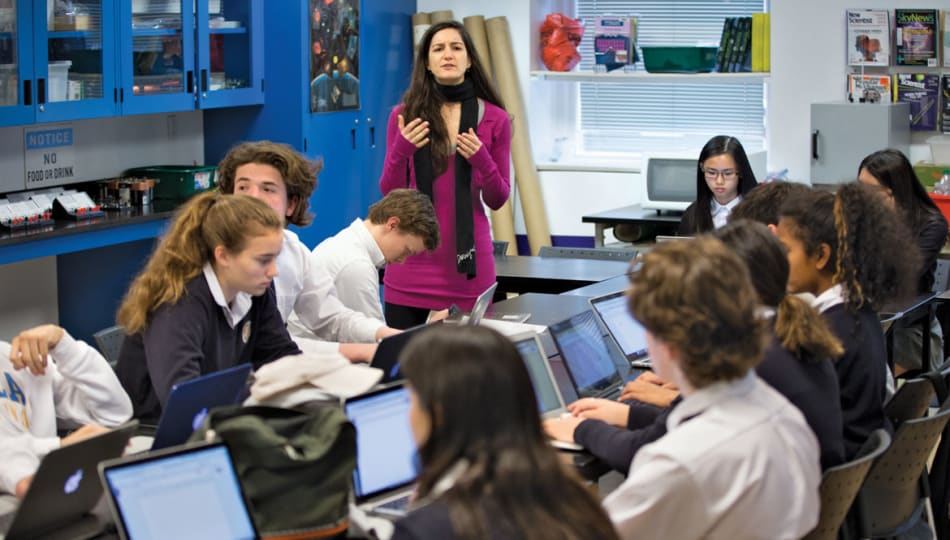
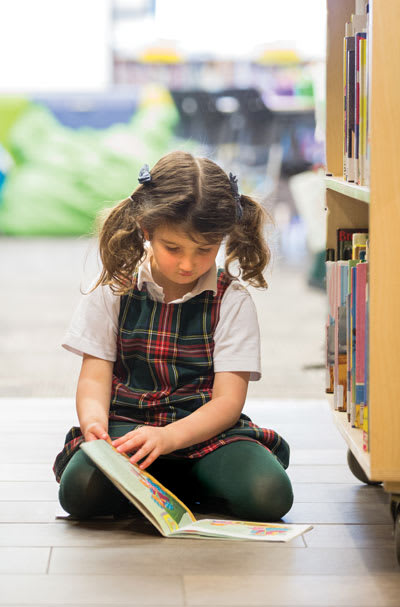
Getting in
Every student who is being considered for admission is asked to come in to spend a full day in the school, attending classes and meeting other students. It’s a chance for the student to gauge if York is a good fit for them, as well as for the admissions team to see how well they engage with others. In that, and all other aspects of the admissions process, it’s very much a two-way street: the school wants to know that it’s a good fit, and students should be evaluating the school with the same mindset.
There’s a group interview for the grades in which there are larger intakes. “We do that because we want to see how the kids engage with each other,” says Muruganandan. “Are they all telling you that they want to be the prime minister? Or are they listening to each other, talking together about their dreams and aspirations?” He adds that it’s important to see how the students engage with a complete stranger.
All applicants write an essay and, in the upper grades, produce a short video. For the video, three questions are chosen at random from a list of 25. The applicants are asked to answer them, and parents are asked not to give any help—though it’s hard to conceive of parents who wouldn’t. “One of the things that we’ve found helpful,” says Muruganandan, “is that we get to see how kids think on their feet. In an IB school, we want to have kids who are free thinkers.” There is also a writing sample, where the applicant is given 20 minutes to answer a question in writing. This is to get a sense of the quality of their writing as well as further indication of that ability to think on their feet.
There is a significant population of international students at York, though all students are expected to arrive fluent in English. There is no ESL offering, and any deficits in English fluency will be made apparent through the writing samples and the video piece.
“When they come into JK, we’re looking for a curiosity to learn,” says Muruganandan. “When they come into Grades 9, 10, and 11, we want to have evidence that they’re not only curious, but that they’re achieving good grades and are engaged in their communities.”
Tuition and financial aid
Parents report that the school is absolutely upfront with tuition and fees, and the school website bears that out. Fees are clear and set in large text, while additional fees are broken down to the cent. Tuition levels are as you’d expect for a program of this size, scope, and quality.
There is some financial aid available in the form of bursaries. Families need to apply for them independently through Apple Financial, which is a common means of providing needs-based aid. There are entrance scholarships available as well, and they are awarded to incoming students by the school itself. The scholarships were created to recognize academic excellence as well as the values of the school. Award levels vary, and no candidate receives full tuition.
Before- and after-school care are available, as is a meal program, all of which are offered on an opt-in or opt-out basis.
The takeaway
Every school is unique, and The York School is particularly adept at proving the point. Just in terms of the basics, it’s an IB, coed day school in downtown Toronto, and that constellation of attributes alone makes it stand out. It’s also true that every school has its own culture, its own character, and The York School is a particularly good example of that as well. With the latest developments, the school has truly arrived, and the evidence for that is ample. The leadership brings a unique, fresh take to the entire project of learning. It’s supported by a significant program of care, exemplified by an active, engaged wellness team, one situated in daily view of the students through their work and their placement within the facility. That attention is continued in a university counselling office that is as good or better than we’ve seen anywhere. If schools aren’t yet looking to York as an example of how best to counsel students in their move to post-secondary education, they should. In all, it’s not just about beginning early, and being attentive, it’s also about perspective, and the one evidenced here is, frankly, inspiring.
The school is distinguished too by the academic gaze it offers students, encouraging them to look beyond the boundaries of the school, beyond the borders of the city and the country, and to find their place in the world. That can risk sounding grand, admittedly, but there are lots of concrete things throughout the school that you can point to as evidence of that. In speaking with students, too, you get the sense that they are really internalising a wider, more far-reaching perspective. They feel they are dialed in to the city, the country, and the world; the school—from trips downtown and beyond; to interactions with the people in the neighbourhoods of Toronto—to its credit puts a lot of energy into ensuring that they are.
It’s about the little things, too. As Struan Robertson says, “At the end of the day, I think what parents are looking for is a safe, happy place. … It’s when you walk in the building, how does the building make you feel? When you talk to kids, are they happy? … That feeling that you can’t always describe, but when you walk in, you think, ‘hmm, this feels really good.’” That doesn’t just happen. The school needs to adopt it as a goal and then take steps to develop it, and the York School scores high on both counts. It’s perhaps not as well-known as some other schools in the country, or even the city, though that will certainly change.
